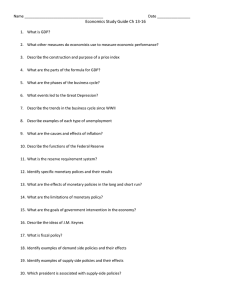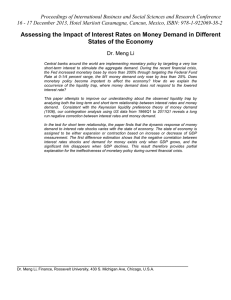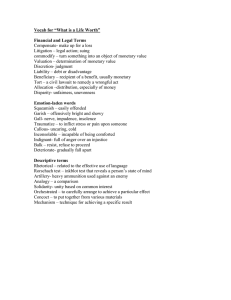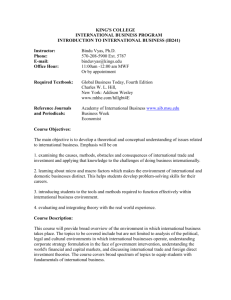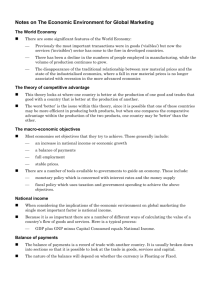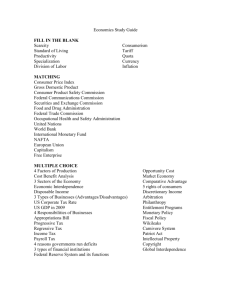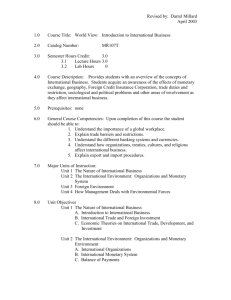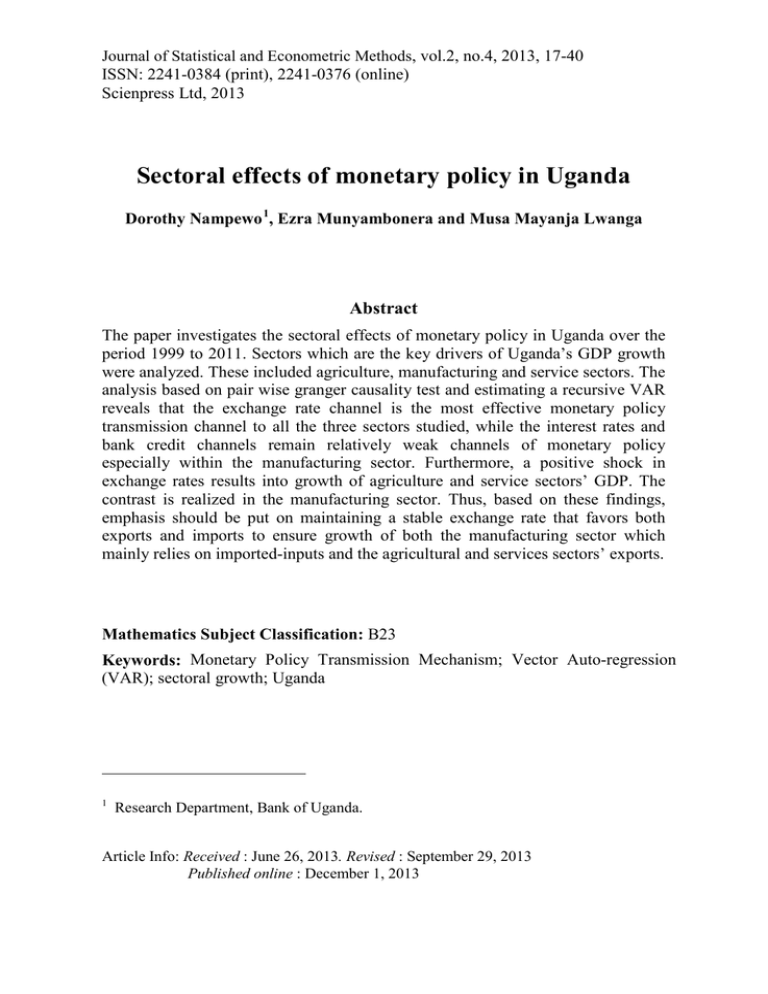
Journal of Statistical and Econometric Methods, vol.2, no.4, 2013, 17-40
ISSN: 2241-0384 (print), 2241-0376 (online)
Scienpress Ltd, 2013
Sectoral effects of monetary policy in Uganda
Dorothy Nampewo 1, Ezra Munyambonera and Musa Mayanja Lwanga
Abstract
The paper investigates the sectoral effects of monetary policy in Uganda over the
period 1999 to 2011. Sectors which are the key drivers of Uganda’s GDP growth
were analyzed. These included agriculture, manufacturing and service sectors. The
analysis based on pair wise granger causality test and estimating a recursive VAR
reveals that the exchange rate channel is the most effective monetary policy
transmission channel to all the three sectors studied, while the interest rates and
bank credit channels remain relatively weak channels of monetary policy
especially within the manufacturing sector. Furthermore, a positive shock in
exchange rates results into growth of agriculture and service sectors’ GDP. The
contrast is realized in the manufacturing sector. Thus, based on these findings,
emphasis should be put on maintaining a stable exchange rate that favors both
exports and imports to ensure growth of both the manufacturing sector which
mainly relies on imported-inputs and the agricultural and services sectors’ exports.
Mathematics Subject Classification: B23
Keywords: Monetary Policy Transmission Mechanism; Vector Auto-regression
(VAR); sectoral growth; Uganda
1
Research Department, Bank of Uganda.
Article Info: Received : June 26, 2013. Revised : September 29, 2013
Published online : December 1, 2013
18
Sectoral effects of monetary policy in Uganda
1 Introduction
Uganda’s economy has experienced impressive growth rates averaging about
7 percent over the past two decades. This has been achieved through a
macroeconomic management strategy aimed at securing price stability as the
anchor for realization of growth. However, this strategy has focused on mitigating
aggregate demand through restrictive monetary policy and hence high interest
rates that continue to hurt private investment and growth. The extent of the impact
of monetary policy on growth has raised issues of concern among policy makers.
Particularly, the channels through which the monetary policy impulse is
transmitted to the productive sectors of the economy, has been a subject of debate
among policy makers.
Literature shows that, monetary policy may have adverse effects on sectoral
growth and consequently on overall growth and that; different sectors of the
economy react differently to monetary policy shocks (Serju, 2003; Alam and
Waheed, 2006 and Dhal, 2011). Therefore, it is necessary to know which sectors
respond first to a policy shock and whether the effects could be more prominent in
some sectors than in others. This may provide relevant information for policy
purposes (Ganley and Salmon, 1997). For the case of Uganda, as is clearly
stated in the National Development Plan, emphasis is put on developing
agriculture and manufacturing as the primary growth sectors that will drive the
economy to economic transformation (NDP 2010). Thus, empirical evidence on
how these sectors react to monetary policy shocks is relevant for policy direction
on how to boost growth. Indeed, studies on sectoral analysis of monetary policy
transmission channels in other developing countries, particularly, Nigeria and
Jamaica, indicate that contractionary monetary policy adversely affects agriculture
and manufacturing, which are regarded as the primary growth sectors for most
developing economies (Serju, 2003 and Ifeakachukwu and Olufemi, 2012).
In Uganda, studies on monetary policy and growth, for example Mugume
(2011), have focused on the effect of monetary policy on overall real output
growth. However, empirical evidence and the documentation pertaining to the
effect of monetary policy at the sector level in Uganda is scanty and less studied.
This raises two important research questions: How do the different sectors of the
economy react to monetary policy effects in Uganda? Has this got any policy
implications on overall growth? Based on the identified empirical gap and the
research questions, this study sets out to examine the sectoral effects of monetary
policy in Uganda. To this effect, three sectors that are key drivers of Uganda’s
GDP growth are analyzed. These include; agriculture, manufacturing and service
sectors. Unlike many similar studies in other developing countries that focus on
one transmission channel, this study is distinctive as it uses an extensive approach
based on the three relevant channels of monetary policy transmission (exchange
rate, interest rate and bank credit) for Uganda. The asset price channel is not
effective in Uganda due to a small and under developed capital market, thus is not
examined in this study.
D. Nampewo, E. Munyambonera and M.M. Lwanga
19
This study builds on Mugume (2011) to investigate the impact of monetary
policy at the sectoral level. It employs a structural recursive Vector Autoregressive
framework, which, following Sims (1980), has become the methodology of choice
for investigating the impact of monetary policy in the economy. This framework
has the advantage that it offers an empirical link between data and theory in
economics. In a developing country context in particular, it is even more
appropriate since the intricate functioning of the economy at a macro-level makes
the exclusion restrictions required in structural approaches implausible. The
findings of this study will build on the existing literature surrounding the effects of
monetary policy on growth, and will be relevant for policy purposes.
The rest of the paper is organized as follows: section 2 looks at the
theoretical framework, section 3 looks at the review of related literature and
section 4 highlights the methodology and estimation procedures. The empirical
results, conclusions and policy considerations are presented in sections 5 and 6
respectively.
2 Theoretical framework
Monetary policy transmission mechanism is defined as the channel through
which changes in money supply affects the decisions of firms, households,
financial intermediaries, investors and ultimately alters the level of economic
activity and prices (Mishikin 1996 and Kuttner 2001). This study employs the
Keynesian approach of monetary theory transmission mechanism to real sector
growth. It focuses on the analysis of monetary policy transmission channels from
the aggregate demand side of the economy. This is so because aggregate supply is
assumed to be fixed in the short run and flexible in the long run due to automatic
adjustments in the economy arising from monetary policy shocks (Ifeakachukwu
et al, 2012). However, these Keynesian assumptions do not realistically apply to
Uganda as the structure of the economy is not sufficiently developed to allow for
the required automatic adjustments.
On the aggregate demand side, monetary policy effects are channeled
through the exchange rates, interest rates and asset prices or wealth channels
which consequently affect bank credit channels. Thus, the transmission effect of
monetary policy to growth will be explored through analysis of these channels.
The interest rate channel is bench-marked on the conventional Taylor (1993)
rule in equation 1, which reflects the actions of the monetary authority to adjust
policy rates in relation to inflation and output movements.
rt βπ t + δ yt
=
(1)
where; rt is the short term interest rate, π t is the inflation rate and yt is the
output
Under this framework, a contractionary monetary policy reflected through a
20
Sectoral effects of monetary policy in Uganda
positive shock to the short term interest rate leads to a rise in the domestic real
interest rates. This in turn, increases the cost of capital and further reduces; the
amount of credit to the private sector hence forcing households to cut back on
their expenditures, which constrains investment and eventually results in positive
inflationary pressures hence negative output growth (Mishikin, 2004).
In open economies, the effects of the policy induced rate (short term interest
rate) are most pronounced through the exchange rate channel (Ireland, 2005). This
mainly arises from interest rate differentials between domestic interest rates and
foreign interest rates. A contractionary monetary stance creates an appreciation
of the exchange rate. This is due to increasing capital inflows arising from the
high domestic interest rates relative to foreign rates. The exchange rate
appreciation poses negative implications for investment and export demand since
it makes local goods more expensive as compared to foreign goods. Appreciation
therefore reduces output on account of lesser investment and net exports. The
exchange rate channel is inspired by the uncovered purchasing power parity in
equation 2, which clearly relates short term interest rates and output growth to
exchange rate movements.
et = ϕ et −1 + ϕ et +1 + β i* + δ yt
(2)
where; et is the nominal exchange rate, i * is the interest rate differential and
yt is the output.
Equation 3 is the Phillips curve which reveals that inflation depends on the
expected inflation, the domestic output gap and the real exchange rate. Further to
equation 2, we conclude from equation 3 that exchange rates directly affect
inflation through its effect on the prices of net exports.
π t = βπ t e + δ y*t + ϕ et + ε t
(3)
Where; π t is the expected inflation rate, y *t is the domestic output gap et is
the real exchange rate and ε t is the stochastic error term.
The bank credit channel has an indirect transmission effect from monetary
policy upon growth. A contractionary monetary policy stance, through reducing
bank reserves and bank deposits, constrains the quantity of bank loans available to
borrowers (Bernanke and Gertler, 1989). This ultimately reduces private
investment and output.
Regarding the asset price channel, the transmission mechanism effect is
analyzed based on two aspects: the Tobin (1969)’s q theory of investment and the
wealth effect. The Tobin’s q theory of investment defines q as the market value of
firms divided by the cost of depreciation. Therefore, a contractionary monetary
policy will trigger a rise in asset prices, given the increase in domestic interest
rates relative to foreign interest rates. The high asset prices imply a high value of
q-as defined above. As the market value of firms increases, so will investment
expenditure. On the wealth aspect, an increase in asset prices increases the
e
D. Nampewo, E. Munyambonera and M.M. Lwanga
21
financial wealth of consumers and thus increases consumers’ life time resources,
which in turn increases household’s consumption expenditures (Mishkin, 1996).
But recall that the asset price channel is not relevant to Uganda due to a small and
under developed capital market.
Overall, the level of economic activity in an open economy is summarized in
equation 4 - the IS aggregate demand model. This model follows that developed
by Ireland (2005) and Sznajderska (2011). Based on this model, economic activity
is majorly determined by; the level of economic activity in the previous and future
periods; the real interest rates; the real exchange rates and any other factors arising
mainly from supply related shocks in the economy. As discussed earlier, high
interest rates constrain the level of economic activity whereas, depreciation in the
real exchange rates promotes growth through its effect on net exports. With regard
to monetary transmission mechanism, equation 4; clearly points out the channels
of monetary policy transmission. The interest rate and asset price channels are
reflected in the coefficient of real interest rates ( β ); the exchange rate channel is
reflected in the coefficient of the real exchange rate ( λ ); and the credit channel is
reflected in the coefficient of the interest rate spread ( δ ).
yt =λt + α1 yt −1 + α 2 yt +1 + β rt + λ et + δ i* + ε t
(4)
where; y t −1 and yt +1 is the previous and expected growth in output respectively;
rt is the real interest rates, et is the real exchange rate, i * the spread between
interest on loans and the market interest rate and ε t is the error term reflecting
other stochastic shocks to the economy.
3 Review of related literature
There is increasing interest between researchers and policy makers on the
transmission effects of monetary policy on the real sector. As a result, numerous
studies on the transmission channels of monetary policy on overall real sector
growth have been conducted for both developed and emerging economies.
However, there are ever increasing debates upon how monetary policy affects the
different sectors of the economy. There is scanty literature surrounding the impact
of monetary policy on the real sector at a disintegrated level.
Mugume (2011) analyzes the transmission channels of monetary policy in
Uganda using a structural VAR model. The results from the impulse responses
and variance decomposition analysis revealed that monetary policy influences
inflation 2 and real economic activity. However, the distribution of the impact at
2
The overall objective of monetary policy is price stability.
22
Sectoral effects of monetary policy in Uganda
the sectoral level was not considered. Hence, a sectoral analysis of monetary
policy is necessary to guide the appropriate policies to spur Uganda’s economic
growth.
Studies undertaken in other emerging economies indicate that indeed
monetary policy has significant and distinct impacts upon different sectors of the
economy. Ifeakachukwu and Olufemi (2012) use an unrestricted VAR approach to
analyze the impact of monetary policy on the Nigerian economy at the
multi-sectoral level. The results of their study reveal that the agriculture and
manufacturing sectors are most affected by interest rates, while other sectors such
as building/construction, mining, and wholesale/retail sectors are more affected by
exchange rate shocks. The study further concludes that interest rate and exchange
rate policies were the most effective monetary policy measures in stimulating
sectoral output growth in Nigeria.
Cardia and Murcia (2004) uses a dynamic stochastic general equilibrium
(DSGE) model to analyze the transmission of monetary policy in a multi-sector
economy. Their results show a strong sensitivity to monetary policy shocks on the
part of construction and durable manufacturing. These results confirm the findings
of Serju (2003) who showed that the manufacturing sector experiences the largest
and quickest decline in response to an interest rate shock in Jamaica. Furthermore,
Ilker (1999), using a VAR estimation method found that small manufacturing
firms are more affected by interest rate shocks while large manufacturing firms are
prone to exchange rate shocks. This may also apply to Uganda, as it is equally a
small open economy that has a manufacturing sector characterized by both small
and large domestic and international firms.
Sahinoz and Cosar (2009) investigate the response of output in the Turkish
manufacturing sector to a contractionary monetary policy shock using a vector
autoregressive framework. Their findings show that the manufacturing sector
largely responds to a contractionary monetary policy shock via the exchange rate
channel. Similarly, Mehdi and Reza (2011) use the auto regressive distributed lag
(ARDL) model to establish the effect of monetary policy on Iran’s industrial
sector. Their results also indicate that monetary policy affects Iran’s industrial
sector mostly through the exchange rates and bank credit channels. The significant
impact of exchange rate shocks to the manufacturing sector points to the nature of
manufacturing firms within these economies: large in size both in terms of exports
and imports of their product and inputs respectively.
A tight monetary policy deters growth throughout the different sectors of the
economy. This is confirmed by Karim et al (2006) who use a VAR approach to
study the impact of contractionary monetary policy on different sectors of the
Malaysian economy. Their findings suggest that the negative impact of
contractionary monetary policy has the largest effect upon the agriculture,
manufacturing and mining sectors in Malaysia. In Uganda, the relationship
between agriculture, manufacturing, mining and monetary policy may be even
greater given that these have a much larger weight in the Ugandan economy.
D. Nampewo, E. Munyambonera and M.M. Lwanga
23
Lawson and Rees (2007) use a structural VAR to analyze the effect of monetary
policy on production and expenditure in Australia. They argue that on the
expenditure side, dwelling and machinery & equipment investment are the most
interest-sensitive sectors of gross domestic product in the Australian economy,
while construction and retail trade are the most interest-sensitive sectors on the
production side of the economy.
In summary, the monetary policy transmission mechanisms largest channel
of influence upon growth varies at the sector level. This has implications for
aggregate growth, depending on a sector’s contribution to national GDP. The
agriculture and services sectors are mostly affected by interest rate and exchange
rate channels. The effect of monetary policy shocks on the manufacturing sector is
most prounced through the exchange rate channel. We can also conclude from the
literature that VAR, DSGE and ARDL methodologies are the widely used
approaches to investigate monetary policy effects upon growth. This study will
adopt the VAR approach. The strength of the VAR approach over the other
approaches suggested in the literature is that it provides a link between the
estimated model residuals and the structural shocks of the underlying macro
economy which are relevant for the identification of specific innovations of the
variables within the estimated model (Garratt.et.al, 1998). Besides, it is the
preferred approach for short run iterations between different variables (Jamilov,
2012).
4 Data and Methods
4.1 Model specification
The empirical approach employed in this study is the VAR framework.
This approach is widely used in economic analysis because it provides a link
between economic theory and macroeconomic variables. In this study, three
VAR systems were estimated. Each system consists of six endogenous variables
including: 91- day Treasury bill interest rate (Tb), regarded as the reference rate
and used as a proxy to signal the monetary policy stance; the lending interest rate
(LR), included to capture the interest rate channel; the nominal exchange rate
(EXT), included to capture the dynamics of the monetary policy transmission
mechanism through the exchange rate channel; credit to private sector (PR),
included to capture the bank credit channel; CPI inflation (CPI), included to
capture inflation; and finally sectoral GDP for agriculture (AGRIC),
manufacturing (MAN) and services (SER), included to capture the sectoral
outputs.
The analysis was based on quarterly data spanning from 1999Q1 to 2011Q2.
The data was de-seasonalised to take care of the seasonal elements in the model.
The VAR model for this study was specified as follows:
24
Sectoral effects of monetary policy in Uganda
=
Axt B( L) Lxt + ε t
(5)
where:
xt is a k x1 – dimensional Vector of the endogenous variables, A is a k x k dimensional autoregressive coefficient matrices, L is the lag operator, that is;
Lxt = xt −1 and B( L) is B0 + B1 L + B2 L2 + ... + Bk Lk is the autoregressive lag
order polynomial; while, ℇt is dimensional vector of the stochastic error term
nominally distributed with white noise properties N (0, σ2).
In order to capture the impact of shocks within the monetary policy variables
upon sectoral output, a structural recursive VAR model is estimated from the
reduced VAR form. Thus, from equation (5), the reduced form VAR is estimated
in equation (6)
=
xt A−1 B( L) Lxt + µt
(6)
where: µt is A−1 , et is a vector of reduced form residuals with E (utut’) =Ω.
Structural shocks are generated using cholesky decomposition of the
variance-covariance matrix of the reduced form VAR residuals, Ω, from equation
(6). The relationship between the reduced form VAR residuals and the structural
disturbances is presented in equation (7).
tb
1
ε
a
ε lr
21
pr
ε = a31
ε ext
a41
cpi
a51
ε
gdp
a61
ε
0
1
a32
a42
a52
a62
0
0
1
a43
a53
a63
0
0
0
1
a54
a64
0
0
0
0
1
a65
0
0
0
0
0
1
tb
µ
µ lr
tpr
µt
µ ert
t
µtcpi
gdp
µt
(7)
Where µt tb denotes monetary policy shocks, µtlr interest rate shocks, µtpr credit to
the private sector shocks, µtext exchange rate shocks, µtGDP aggregate
demand/sectoral output shocks and µtCPI inflation shock. The structural model is
identified because the k (k-1)/2 restrictions are imposed on the matrix A as zero
restrictions where k denotes the number of endogenous variables in the VAR
system.
The resulting matrix implies that in the first equation, a monetary policy
shock is not a reaction to changes in the other variables in the model. In equation
2, lending rates respond to monetary policy shocks only, in equation 3, private
sector credit responds to the monetary policy and resultant lending rate shocks
only; in equation 4, the nominal exchange rate responds to the monetary policy
shocks, the lending rates shocks and shocks due to private sector credit only;. in
D. Nampewo, E. Munyambonera and M.M. Lwanga
25
equation 5 and 6, inflation and aggregate demand/sectoral outputs reacts to all the
shocks due to other variables in the system.
Based on this specification, the model is estimated as structural recursive
VAR using cholesky decomposition. Impulse response analysis will be used to
show the response of aggregate demand/sectoral outputs and core inflation to
shocks in the other variables in the model. From this analysis, the effective
transmission channels of monetary policy shocks will be identified. Additionally,
variance decomposition analysis will enable us to determine the importance of
each of the variables on influencing the sectoral outputs and inflation.
4.2 Data source
Data was collected from the Uganda Bureau of Statistics (UBoS) and Bank
of Uganda (BoU) database. Data on sectoral GDP for agriculture, manufacturing
and services was collected from UBoS. Data on interest lending rates, nominal
exchange rates, credit to the private sector and 91-day treasury bill rates was
collected from the BoU database. All variables were transformed to logarithmic
form except for the lending rates (LR) and treasury bill rates (TB).
4.3 Estimation procedure
Based on the above model specification, it is appropriate to determine the
time series properties in the VAR specification. The time series properties of the
endogenous variables are plotted in appendix 2. All variables appear to contain a
deterministic trend save for the lending rate. Further, the variables in the model
were subjected to unit root tests using the Augmented Dickey-Fuller (ADF) test.
The results of the ADF test were compared with the Philips Peron (PP) test to
confirm the order of integration. The unit root tests confirm that the outputs for the
three sectors considered in the analysis are I(0), whilst the monetary policy
variables are I(1). In other words, the monetary policy variables become stationary
after first differencing. The results of the unit root tests are presented in Annex 2.
Despite the stationarity tests conducted on the variables, the VAR model was
estimated in levels in order to avoid losing information surrounding possible
long-run relationships among the variables. This was confirmed by Sims, Stock
and Watson, 1990.
The appropriate lag length was selected based on the LR test and the Akaike
Information Criteria (AIC). Based on this criterion a common lag length of 2
quarters for each VAR model was adopted. The selection of this lag length is
appropriate for whitening the errors in the model as confirmed with the LM test
for serial autocorrelation (Annex 3). The results of the lag selection criteria are
presented inTable 1 below.
26
Sectoral effects of monetary policy in Uganda
Table 1: Lag selection criteria
VAR Lag Order Selection
Criteria
Endogenous variables: LR LPR LEXT LCPI LSER
LAGRIC LMAN
Exogenous variables: C
Lag
LogL
LR
FPE
AIC
SC
HQ
0
428.0372
NA
7.09e-17
-17.32073
-16.49407
-17.00965
1
588.7920
253.1032
6.38e-19
-22.07625
-19.32071*
-21.03933*
2
642.7054
68.82566*
6.29e-19*
-22.28534*
-17.60092
-20.52256
* indicates lag order selected by the criterion
LR: sequential modified LR test statistic (each test at 5%
level)
FPE: Final prediction error
AIC: Akaike information criterion
SC: Schwarz information criterion
HQ: Hannan-Quinn information criterion
This study uses a structural analysis of the VAR model based on three
approaches namely granger causality, impulse response analysis and the forecast
variance decomposition. To estimate the power of forecasting among variables,
the granger causality test is performed to determine whether lags of one
endogenous variable significantly improved the forecasting performance of
another variable for each VAR model. In other words bivariate granger causality
tests are conducted to show the direction causation between variables.
The impulse response analysis is estimated to examine how the impact of a
shock in one variable transmits through the dynamic lag structure of the VAR
model to other endogenous variables in the VAR model, while the forecast error
variance decomposition estimates the proportion of a shock to a given variable due
to its own shock or shocks to other variables within the VAR model in a given
forecasting time period.
4.4 Analysis of robustness
a) Testing the model stability
A VAR model is said to be stable if the roots of the characteristic polynomial
have a modulus of less than one and also lie within the radius of the circle.
D. Nampewo, E. Munyambonera and M.M. Lwanga
27
Inverse Roots of AR Characteristic Polynomial
1.5
1.0
0.5
0.0
-0.5
-1.0
-1.5
-1.5
-1.0
-0.5
0.0
0.5
1.0
1.5
Figure 1: The AR test for model stability
The AR graph in figure 1 reveals that the coefficients matrix characteristic roots
have modules of less than unit. In addition, the AR graph also indicates that the
roots lie within the unit circle. This confirms the stability of the VAR model.
b) Diagnosis of residual terms
Another important element in robustness checks for VAR models is ensuring
that the error terms are white noise. That is, there should be no issues of
autocorrelation, the error terms should have constant variance (homoscedastic)
and most importantly the model should be normally distributed. In this analysis,
the portmanteau test was used to test for serial correlation of the residuals.
According to Table 2, the probability values allow us to accept the null hypothesis
that there is no serial correlation in the model. This finding is also confirmed in by
the LM test which reveals no serial correlation among the error terms (Annex 3).
The white’s test was conducted to test for homoscedacity of the residuals in
the model. The null hypothesis states that all the residuals have constant variance
or are homoscedastic. The results in Table 3 reveal that the probability value
remains higher than the 5 percent level of confidence hence we accept the null
hypothesis that the residuals are homoscedastic.
28
Sectoral effects of monetary policy in Uganda
Table 2: Testing for residual autocorrelation using the Portmanteau Test
Null Hypothesis: no residual autocorrelations up to lag h
Sample: 1999Q1 2011Q2
Included observations: 48
Lags
Q-Stat
Prob.
Adj Q-Stat
Prob.
df
1
33.65932
NA*
34.37548
NA*
NA*
2
77.12946
0.8669
79.73562
0.8154
92
3
140.2834
0.5012
147.0998
0.3454
141
4
191.8270
0.4492
203.3292
0.2412
190
5
239.4346
0.4799
256.4726
0.2087
239
6
277.5252
0.6606
300.0047
0.3012
288
7
317.7340
0.7676
347.0784
0.3409
337
8
350.0031
0.9056
385.8013
0.4933
386
9
390.5241
0.9382
435.6733
0.4819
435
10
427.5419
0.9692
482.4326
0.5116
484
* The test is valid only for lags larger than the VAR lag order.
df is degrees of freedom for (approximate) chi-square distribution
* df and Prob. may not be valid for models with exogenous variables
D. Nampewo, E. Munyambonera and M.M. Lwanga
Table 3:
29
Testing the residual homoscedasticity
Joint test:
Chi-sq
df
Prob.
914.6672
896
0.3250
Individual components:
Dependent
R-squared
F(32,14)
Prob.
Chi-sq(32)
Prob.
res1*res1
0.743162
1.265909
0.3276
34.92862
0.3306
res2*res2
0.610742
0.686433
0.8155
28.70487
0.6341
res3*res3
0.787051
1.616986
0.1702
36.99142
0.2493
res4*res4
0.712499
1.084232
0.4539
33.48744
0.3950
res5*res5
0.842786
2.345336
0.0461
39.61096
0.1668
res6*res6
0.770753
1.470921
0.2237
36.22539
0.2779
res7*res7
0.662919
0.860407
0.6519
31.15718
0.5090
res2*res1
0.690871
0.977766
0.5432
32.47093
0.4436
res3*res1
0.804341
1.798531
0.1216
37.80402
0.2212
res3*res2
0.471507
0.390325
0.9863
22.16083
0.9030
res4*res1
0.801597
1.767603
0.1287
37.67504
0.2255
res4*res2
0.693271
0.988839
0.5335
32.58372
0.4381
res4*res3
0.925918
5.468103
0.0008
43.51814
0.0842
res5*res1
0.746156
1.285997
0.3157
35.06932
0.3246
res5*res2
0.484205
0.410706
0.9816
22.75765
0.8858
res5*res3
0.847022
2.422385
0.0405
39.81003
0.1615
res5*res4
0.721934
1.135865
0.4145
33.93088
0.3746
res6*res1
0.565609
0.569657
0.9075
26.58361
0.7372
res6*res2
0.717543
1.111409
0.4328
33.72453
0.3840
res6*res3
0.612808
0.692431
0.8102
28.80198
0.6292
res6*res4
0.729464
1.179662
0.3833
34.28482
0.3587
res6*res5
0.767060
1.440664
0.2368
36.05181
0.2846
30
Sectoral effects of monetary policy in Uganda
Table 4: Testing for normality of the VAR Residuals
Orthogonalization: Cholesky (Lutkepohl)
Null Hypothesis: residuals are multivariate normal
Sample: 1999Q1 2011Q2
Included observations: 48
Component
Skewness
Chi-sq
1
-0.050459
0.019945
2
0.074167
0.043090
3
-0.168052
0.221224
4
-0.011896
0.001109
5
-0.294465
0.679226
6
-0.580251
2.637418
7
-0.332690
0.867012
Joint
4.469022
Component
Kurtosis
Chi-sq
1
2.740291
0.132087
2
2.060466
1.728666
3
4.068043
2.233901
4
2.551183
0.394480
5
4.840621
6.634607
6
3.318607
0.198791
7
2.885145
0.025834
Joint
11.34837
Component
Jarque-Bera
df
1
0.152032
2
2
1.771756
2
3
2.455125
2
4
0.395589
2
5
7.313833
2
6
2.836209
2
7
0.892845
2
df
1
1
1
1
1
1
1
7
df
1
1
1
1
1
1
1
7
Prob.
0.9268
0.4124
0.2930
0.8205
0.0258
0.2422
0.6399
Joint
0.3247
15.81739
14
Prob.
0.8877
0.8356
0.6381
0.9734
0.4099
0.1044
0.3518
0.7244
Prob.
0.7163
0.1886
0.1350
0.5300
0.0100
0.6557
0.8723
0.1241
5 Results and discussion
a)
Pair wise granger causality
The pair-wise granger causality test was employed to identify the possible
transmission channels of monetary policy to sectoral outputs. For this purpose,
D. Nampewo, E. Munyambonera and M.M. Lwanga
31
pair wise granger causality tests were employed between each sectoral GDP and
each monetary policy variable (lending interest rates, bank credit and the exchange
rate). The results are presented in table 6. The results reveal a unidirectional
causation from each monetary variable to the sectors’ GDP save for the
manufacturing sector, which reveals no causation between lending interest rates
and manufacturing GDP. This implies that all channels of monetary policy are
fundamental in transmitting monetary policy effects to sectoral GDP growth.
However, the lending interest channel may be weak in the manufacturing sector.
Table 6: Pair-wise granger causality tests for sectoral outputs
Ho
F-statistic
P-value
Conclusion
Agriculture GDP does not Granger Cause interest rates
0.363
0.70
Accept
Interest rates do not Granger Cause Agriculture GDP
3.627
0.03
Reject
Agriculture GDP does not Granger Cause private sector credit
0.606
0.55
Accept
Private sector credit
4.052
0.02
Reject
Agriculture GDP does not Granger Cause exchange rate
1.657
0.20
Accept
Exchange rate
3.09
0.05
Reject
Manufacturing GDP does not Granger Cause interest rates
0.663
0.52
Accept
Interest rates do not Granger Cause Manufacturing GDP
0.007
0.99
Accept
Manufacturing GDP does not Granger Cause private sector credit
0.811
0.45
Accept
Private sector credit
do not Granger Cause Manufacturing GDP
3.751
0.03
Reject
Manufacturing GDP does not Granger Cause exchange rate
1.386
0.24
Accept
Exchange rate do not Granger Cause Manufacturing GDP
3.128
0.08
Reject
Service GDP does not Granger Cause interest rates
1.93957
0.14
Accept
Interest rates do not Granger Cause services GDP
3.08507
0.04
Reject
Service GDP does not Granger Cause private sector credit
0.64300
0.43
Accept
Private sector credit
5.66815
0.02
Reject
Services GDP does not Granger Cause exchange rate
1.68331
0.20
Accept
Exchange rate does not Granger Cause services GDP
2.59634
0.09
Reject
does not Granger Cause Agriculture GDP
does not Granger Cause Agriculture GDP
does not Granger Cause services GDP
b)
Impulse response functions
The impulse response analysis was based on the impact of a positive one
standard deviation shock from the monetary policy variables upon agricultural,
manufacturing and services GDP. The effect of shocks from the monetary
variables upon sectoral outputs was considered to examine the transmission
channels of monetary policy at the sectoral level. The results of the impulse
32
Sectoral effects of monetary policy in Uganda
response functions for the three sectors are presented in figures i), ii) and iii)
i)
Agricultural sector
Response to Cholesky One S.D. Innovations ± 2 S.E.
Response of LPR to LR
Response of LR to LR
Response of LEXT to LR
.03
1.5
.02
.020
.016
.005
.02
1.0
Response of LAGRIC to LR
Response of LCPI to LR
.010
.04
.012
.01
.000
.00
.00
-.01
-.02
.008
-.005
0.5
-.010
-.02
0.0
-.004
-.04
-.015
-.03
-0.5
-.04
10
5
15
20
25
30
35
.004
.000
-.020
-.06
5
10
15
20
25
30
35
-.008
5
10
15
20
25
30
35
-.012
5
10
15
20
25
30
35
5
10
15
20
25
30
35
30
35
Response to Cholesky One S.D. Innovations ± 2 S.E.
Response of LR to LPR
Response of LPR to LPR
.06
Response of LEXT to LPR
Response of LCPI to LPR
.08
.8
.06
.04
.4
Response of LAGRIC to LPR
.03
.015
.010
.02
.04
.005
.02
.01
.02
.000
.0
.00
.00
.00
-.02
-.005
-.01
-.02
-.4
-.04
-.04
5
10
15
20
25
30
35
5
10
15
20
25
30
35
-.010
-.015
-.02
5
10
15
20
25
30
35
5
10
15
20
25
30
35
5
10
15
20
25
Response to Cholesky One S.D. Innovations ± 2 S.E.
Response of LEXT to LEXT
Response of LPR to LEXT
Response of LR to LEXT
.04
.08
.06
.02
.04
Response of LAGRIC to LEXT
Response of LCPI to LEXT
.6
.010
.4
.005
.2
.000
.0
-.005
-.2
-.010
-.4
-.015
.02
.00
.01
.02
-.02
.00
-.04
-.02
-.04
-.06
5
10
15
20
25
30
35
-.6
5
10
15
20
25
30
35
.00
-.020
5
10
15
20
25
30
35
-.01
5
10
15
20
25
30
35
5
10
15
20
25
30
35
Source: Authors’ own computations
In the agricultural sector, the impulse response functions reveal that a one
standard deviation positive shock in lending interest rates results into a reduction
in agricultural GDP. A rise in lending interest rates reduces agriculture GDP and
takes full effect after about 6 quarters. On the other hand, a positive shock in
credit to the private sector results into growth in the sector’s GDP as shown in the
impulse responses above. The maximum impact of the shock to the sector is
realized after 5 quarters. Similarly, a positive shock in the exchange rates
(exchange rate depreciation) results into an increase in the sector’s GDP with the
D. Nampewo, E. Munyambonera and M.M. Lwanga
33
maximum impact felt after about 4 quarters. The results of the impulse response
analysis in the agricultural sector reveal that whereas the sector is negatively
affected by high lending rates, an increase in credit and exchange rate depreciation
spurs growth in the sector. We can further conclude that the interest rate, credit
and the exchange rate channels are effective monetary policy transmission
channels in the agricultural sector.
ii)
Manufacturing sector
Response to Cholesky One S.D. Innovations ± 2 S.E.
Response of LR to LR
Response of LPR to LR
1.6
Response of LEXT to LR
.03
.02
.02
.01
1.2
.01
0.8
.00
0.4
-.01
Response of LCPI to LR
Response of LMAN to LR
.012
.010
.008
.005
.004
.00
.000
.000
-.01
-.005
0.0
-0.4
5
10
15
20
25
30
-.03
-.03
-.04
-.04
35
-.004
-.02
-.02
5
10
15
20
25
30
-.010
-.008
-.012
-.015
35
5
10
15
20
25
30
35
5
15
10
20
25
30
35
5
10
15
20
25
30
35
Response to Cholesky One S.D. Innovations ± 2 S.E.
Response of LPR to LPR
Response of LR to LPR
Response of LEXT to LPR
.8
.06
.04
Response of LCPI to LPR
.06
.03
.04
.02
.02
.01
.00
.00
Response of LMAN to LPR
.015
.010
.4
.005
.02
.000
.0
.00
-.005
-.02
-.02
-.01
-.04
-.02
-.010
-.4
-.04
5
10
15
20
25
30
35
5
10
15
20
25
30
35
5
10
15
20
25
30
-.015
5
35
10
15
20
25
30
35
5
10
15
20
25
30
35
Response to Cholesky One S.D. Innovations ± 2 S.E.
Response of LEXT to LEXT
Response of LR to LEXT
Response of LPR to LEXT
.08
.04
.06
.02
Response of LCPI to LEXT
.6
.010
.4
.005
.2
.000
.0
-.005
-.2
-.010
-.4
-.015
Response of LMAN to LEXT
.02
.01
.04
.00
.02
.00
-.02
.00
-.01
-.04
-.02
-.04
-.06
5
10
15
20
25
30
35
-.6
5
10
15
20
25
30
35
-.020
5
10
15
20
25
30
35
-.02
5
10
15
20
25
30
35
5
10
15
20
25
30
A positive shock in lending interest rates reveals a weak response in
manufacturing GDP growth as shown in figure ii). Thus, the impulse response
agrees with the granger causality test results which revealed that there is no
causation between the manufacturing GDP and lending interest rates. These
findings are consistent with Ilker (1999). Similarly, the response of the sector’s
GDP to a positive shock in private credit shows more-or-less a weak reaction.
Exchange rate depreciation (a positive shock in exchange rates) however, results
into a decline in manufacturing GDP which takes full effect after about 4 quarters.
We therefore conclude that exchange rate is a more significant channel in
35
34
Sectoral effects of monetary policy in Uganda
transmitting monetary policy in the manufacturing sector while other channels
(interest rates and credit) remain relatively weak in transmitting monetary policy
in the sector. This is true for Uganda’s case because the manufacturing sector
depends mainly on imported inputs therefore; an increase in the exchange rate
increases the cost of production for the sector hence low production.
iii)
Services sector
Response to Cholesky One S.D. Innovations ± 2 S.E.
Response of LR to LR
Response of LPR to LR
1.2
0.8
Response of LCPI to LR
Response of LEXT to LR
Response of LSER to LR
.02
.02
.010
.012
.01
.01
.005
.008
.00
.00
.000
-.01
-.01
-.005
.004
0.4
.000
-.004
0.0
-0.4
-0.8
5
10
15
20
25
30
-.02
-.02
-.010
-.03
-.03
-.015
-.012
-.04
-.04
-.020
-.016
35
5
10
15
20
25
30
35
5
10
15
20
25
30
-.008
35
5
10
15
20
25
30
35
5
10
15
20
25
35
30
Response to Cholesky One S.D. Innovations ± 2 S.E.
Response of LEXT to LPR
Response of LR to LPR
Response of LPR to LPR
.06
.6
.04
.02
.008
.02
.00
.00
-.004
-.02
-.4
.005
.000
-.2
.000
-.008
-.6
-.04
5 10 15 20 25 30 35 40 45 50 55
5 10 15 20 25 30 35 40 45 50 55
.010
.004
.0
-.04
.015
.012
.2
-.02
.020
.016
.4
.04
Response of LSER to LPR
Response of LCPI to LPR
.020
.06
-.012
5 10 15 20 25 30 35 40 45 50 55
-.005
5 10 15 20 25 30 35 40 45 50 55
5 10 15 20 25 30 35 40 45 50 55
Response to Cholesky One S.D. Innovations ± 2 S.E.
Response of LR to LEXT
Response of LEXT to LEXT
.08
.6
.06
.4
Response of LCPI to LEXT
Response of LPR to LEXT
.020
.016
.01
.00
.04
Response of LSER to LEXT
.02
.02
.012
.2
.008
.00
.02
.0
.004
-.02
-.01
.00
.000
-.2
-.04
-.02
-.4
-.04
-.6
5
10
15
20
25
30
35
-.004
-.02
-.008
-.06
5
10
15
20
25
30
35
-.03
5
10
15
20
25
30
35
-.012
5
10
15
20
25
30
35
5
10
15
20
25
30
Finally within the services sector, the impulse response functions reveal that a
one standard deviation positive shock in the lending interest rates results into a
reduction in the services sectors’ GDP. The most significant fall in the services
sector GDP is experienced after about 3 quarters. Regarding the bank credit
channel, a one standard positive shock in bank credit results into an increase in the
sector’s GDP. This takes full effect after about 7 quarters. Turning to the effect
of increasing the exchange rate on sectoral growth, a positive shock in exchange
rates, that is, a depreciation of the exchange rate increases services GDP growth
reaching a maximum increase in GDP after about 4 quarters. The rise in services
35
D. Nampewo, E. Munyambonera and M.M. Lwanga
35
GDP may be on account of increased earnings from services exports due to
increased competitiveness arising from exchange rate depreciation. These findings
are consistent with Ilker (1999), Sahinoz et al (2009), Medhi et al (2011) and
Ifeakachukwu et al (2012).
c)
Variance decomposition analysis
Forecast error variance decomposition describes what proportion of a shock to
a specific variable is related to either its own innovations or to those associated
with other dependent variables at various forecast time horizons in the system. For
the purpose of this analysis, variance decompositions are used to measure the
fraction of sectoral output movements attributable to monetary policy shocks. The
results of the variance decomposition analysis across the three sectors are
presented in Annex 1. The results reveal that, the exchange rate channel is the
most significant channel of transmitting monetary policy effects in the three
sectors studied while the interest rate and the bank credit channels are relatively
weak channels of monetary policy across the sectors. For instance, considering the
9th quarter horizon when monetary policy effects are expected to take full effect;
within the manufacturing sector, about 88.9 percent of variations in the sector’s
GDP was attributed to its own shock, 9.8 percent was due to the exchange rate
innovations, 0.43 percent was due to shocks in bank credit and only 0.42 percent
was attibuted to shocks arising from lending interest rates. Regarding the
agricultural sector, about 61.2 percent of variations within the sector were
attributed to its own shocks, followed by shocks due to exchange rates at about
14.5 percent, shocks to lending interest rates contributed about 10.8 percent while
bank credit shocks accounted for about 7.4 percent of innovations within the
sector. Turning to the services sector, within the same horizon (9th quarter), 69
percent of variations in the sector’s GDP were due to its own shocks, while 11.3,
9.1 and 6.7 percent were due to innovations from exchange rates, bank credit, and
lending interest rates respectively.
6 Conclusions and policy implications
This paper investigates the sectoral effects of monetary policy in Uganda
over the period 1999 to 2011. Precisely the key sectors which are the leading
contributors of Uganda’s GDP were analyzed. These include agriculture,
manufacturing and service sectors. The approach used was based on granger
causality test and a structural recursive VAR framework. The results of the
analysis demonstrate that the exchange rate channel is the most effective channel
of monetary policy to all the three sectors analyzed. The interest rates and the
bank credit channels are relatively weak channels of monetary policy to all the
sectors studied especially the manufacturing sector. A positive shock in exchange
rates (an exchange rate depreciation) negatively affects the manufacturing sector
simply because the sector relays heavily on imported inputs while agriculture and
36
Sectoral effects of monetary policy in Uganda
service sectors benefit from an exchange rate depreciation mainly through the
exports realized from these sectors.
Thus, in terms of policy, caution should be put on maintaining a stable
exchange rate that favours both Uganda’s exports and imports; putting into
consideration that Uganda is a developing economy that relys mostly on imported
raw materials to produce for exports and also the need to maintain the
competitiveness of its exports.
Annex1: Variance decomposition of agriculture, manufacturing
and the services sectors
Variance decomposition of LSER (Services)
Period
S.E.
LSER
LCPI
LR
LPR
LEXT
3
0.035781
84.64848
3.723084
3.581455
2.437291
5.609688
6
0.040026
73.17455
3.619744
7.212140
5.729137
10.26443
9
0.041830
68.97831
3.866078
6.715581
9.104347
11.33568
12
0.042273
68.18922
3.803941
6.608358
10.17263
11.22585
Variance decomposition of LARIC (Agriculture)
Period
S.E.
LAGRIC
LCPI
LR
LPR
LEXT
3
0.031020
76.64566
0.675103
10.25348
2.686672
9.739085
6
0.036155
70.63647
0.598880
9.374771
4.794259
14.32100
9
0.038625
66.74547
0.561490
10.78009
7.412402
14.45024
12
0.039941
66.5555
0.721884
10.74945
7.206366
14.30346
Variance decomposition of LMAN (Manufacturing)
Period
S.E.
LMAN
LCPI
LR
3
0.037630
95.93751
0.332099
0.066148
0.303192
3.361046
6
0.038515
91.62157
0.447789
0.215667
0.367802
7.347173
9
0.039115
88.91321
0.444735
0.422802
0.433429
9.785821
12
0.039506
88.85583
0.440985
0.391975
0.411852
9.588791
Source: Authors’ own computations
LPR
LEXT
D. Nampewo, E. Munyambonera and M.M. Lwanga
37
Annex 2: Time series properties
26
8.0
9.0
8.5
24
7.8
8.0
22
7.5
7.6
20
7.0
7.4
18
6.5
6.0
16
99
00
01
02
03
04
05
06
07
08
09
10
7.2
99
11
00
01
02
03
04
LR
05
06
07
08
09
10
99
11
00
01
02
03
04
LPR
5.4
8.2
5.2
8.0
06
07
08
09
10
11
07
08
09
10
11
LEXT
6.7
6.6
7.8
5.0
05
7.6
4.8
6.5
7.4
4.6
7.2
4.4
6.4
7.0
4.2
6.8
99
00
01
02
03
04
05
06
07
08
09
10
11
6.3
99
00
01
02
03
04
LCPI
05
06
07
08
09
10
11
99
00
01
02
03
LSER
04
05
06
LAGRIC
6.2
6.0
5.8
5.6
5.4
5.2
5.0
99
00
01
02
03
04
05
06
07
08
09
10
11
LMAN
Annex2…Unit root tests
First
difference
In levels
ADF
PP
ADF
PP
variable
Intercept &
trend
Intercept &
trend
Intercept &
trend
Intercept & trend
Conclusion
Lending
rate
-1.8202
-1.8058
-7.3299
-7.3112
I(1)
T-Bill rate
-4.3179
-2.7957
-7.5665
-7.5548
I(1)
Lext
-1.0598
-1.4778
-6.2118
-6.0443
I(1)
LPR
-0.8306
-1.0202
-8.7523
-8.8064
I(1)
Lman
-5.8177
-5.8339
-
-
I(0)
Lagric
-4.3966
-4.3304
-
-
I(0)
Lser
-3.8714
-3.9432
-
-
I(0)
Critical values; -4.1525, -3.5024 & -3.1807 at 1, 5 & 10 percent levels of significance
38
Sectoral effects of monetary policy in Uganda
Annex 3:
LM Test
VAR Residual Serial Correlation LM
Tests
Null Hypothesis: No serial correlation at
lag order h
Sample: 1999Q1 2011Q2
Included observations: 48
Lags
1
2
3
4
5
6
7
8
9
10
11
12
LM-Stat
63.63484
48.29458
71.22552
58.50285
61.78202
43.36823
44.96043
41.35597
55.93562
49.93212
39.20658
53.80773
Prob
0.0780
0.5016
0.0207
0.1659
0.1039
0.6999
0.6376
0.7728
0.2307
0.4361
0.8403
0.2955
References
[1] A. Muwonge, M. Obwona and V. Nambwaayo, Enhancing contributions of
the informal sector to national development”: The case of Uganda, Economic
Policy Research Centre, Research series, 71, 2007.
[2] Bank of Uganda, monetary survey reports
[3] B. Bernanke and M. Gertler, Agency costs, net worth, and business
fluctuations, American Economic Review, American Economic Association,
79(1), (1989), 14-31.
[4] Emanuela Cardia and Francisco J. Ruge-Murcia, The Transmission Of
Monetary Policy In A Multisector Economy, International Economic Review,
Department of Economics, University of Pennsylvania and Osaka University
Institute of Social and Economic Research Association, 50(4), (November,
2009), 1243-1266.
[5] Domac Ilker, The distributional consequences of monetary policy : Evidence
from Malaysia, Policy Research Working Paper Series, 2170, The World
Bank, (1999).
[6] Frederic S. Mishkin, The channels of monetary transmission: Lessons for
monetary policy, NBER working papers series, 5464, (1996).
D. Nampewo, E. Munyambonera and M.M. Lwanga
39
[7] Garratt, Anthony, Lee, Kevin C, Pesaran, M. Hashem and Shin, Yongcheol,
A Structural Co integrating VAR Approach to Macroeconometric
Modeling, Cambridge Working Papers in Economics, 9823, Faculty of
Economics, University of Cambridge, (1998).
[8] J. Granley and C. Salmon, The Industry Impact of Monetary Policy Shock.
Some Stylized Facts, Working paper, 68, Bank of England, (1997).
[9] Jamilov, Rustam (2012): Channels of Monetary Transmission in the CIS
[10] Kenneth N. Kuttner and Patricia C. Mosser, The monetary policy
transmission mechanism: Some answers and further questions, (2001).
[11] Lawson and Rees A Sectoral Model of the Australian Economy, Research
Discussion Paper, 2008-01, (2007).
[12] Mishkin F.S. The economics of money, banking and financial markets,
Pearson Longman, (2004).
[13] Mohd Zaini Abd Karim, Amy Azhar Mohd Harif and Azira Adziz, Monetary
Policy and Sectoral Bank Lending in Malaysia, Global Economic Review,
Taylor and Francis Journals, 35(3), (2006), 303-326.
[14] Mugume. A, Monetary Transmission Mechanisms in Uganda, Bank of
Uganda research series, 2011, www.bou.or.ug
[15] Peter N. Ireland, 2005. "The Monetary Transmission Mechanism," Boston
College Working Papers in Economics 628, Boston College Department of
Economics
[16] Philip Ifeakachukwu, Nwosa and Muibi Olufemi, Saibu, The Monetary
Transmission Mechanism in Nigeria: A Sectoral Output Analysis,
International Journal of Economics and Finance, 4, (2012).
[17] Prudence Serju, Monetary Policy and the Jamaican Economy: A Sectoral
Analysis, Bank of Jamaica, Working Paper, WP02/09, (2003).
[18] Republic of Uganda, Ministry of Finance, Planning and Economic
Development, Background to the budget 1990-2012.
[19] S Sahinöz, EE Cosar, Understanding Sectoral Growth Cycles and the Impact
of Monetary Policy in the Turkish Manufacturing Industry, Journal of
Business Cycle Measurement and Analysis, (2009).
[20] Safdari Mehdi and Motiee Reza, Effects of Monetary Policy on Industry
sector Growth in Iran, pelagiaresearchlibrary.com European-journal, 1(4),
(2011), 29-40.
[21] Sarat Dhal, Industry Effects of Monetary Transmission Mechanism in India:
An Empirical Analysis of Use-based Industries Reserve Bank of India
Occasional Papers, 32(2), Monsoon 2011.
C. Sims, Macroeconomics and Reality, Econometrica, 48(1), (1980), 1-48.
[22] Sims Christopher A, Stock James H and Watson Mark W, Inference in Linear
Time Series Models with some Unit Roots, Journal of Econometrica, (1990).
[23] Sznajderska Anna, Onetary policy transmission Mechanism;
Some
Philosophical and Methodological Aspects, (2011),
www.edamba.eu/userfiles/file/Sznajderska%20Anna.pdf
40
Sectoral effects of monetary policy in Uganda
[24] Tasneem Alam and Muhammad Waheed, 2006: The monetary transmission
mechanism in Pakistan: a sectoral analysis; Pakistan Institute of
Development Economicshttp://mpra.ub.uni-muenchen.de/2719/MPRA Paper,
2719, posted 13. April 2007.
[25] National Development Plan (NDP), 2010/11-2014/15. Growth, Employment
and Socio-Economic Transformation for Prosperity.
[26] Republic of Uganda, 1995 Constitution of Uganda.
[27] Uganda Bureau of Statistics, Statistical abstracts, 1990-2012.

